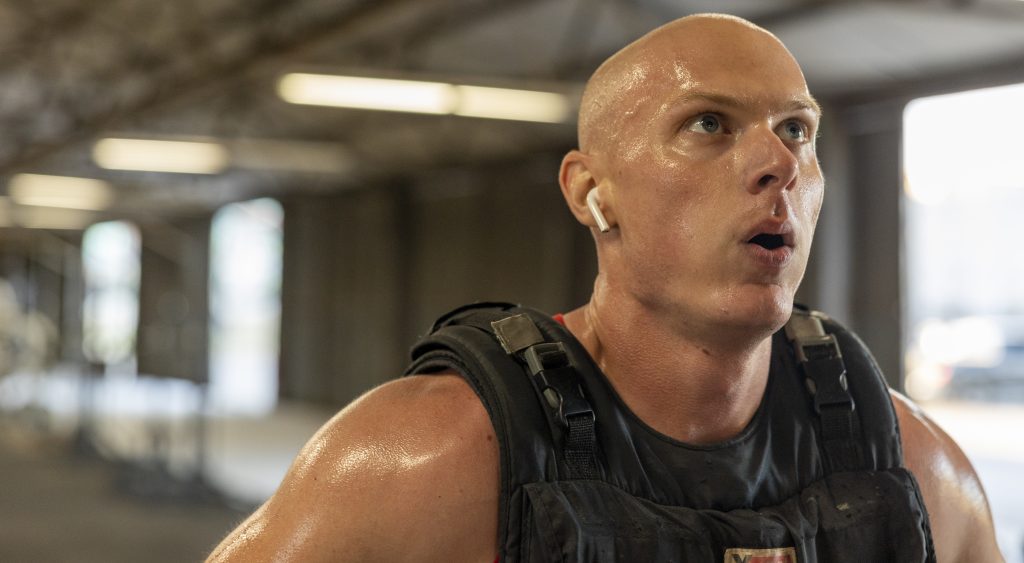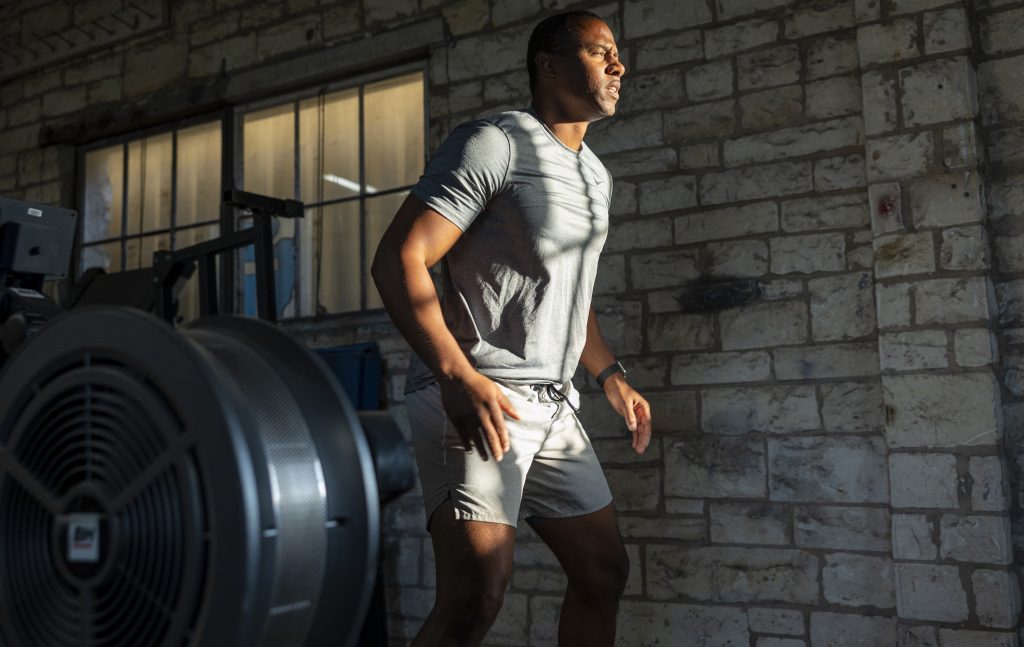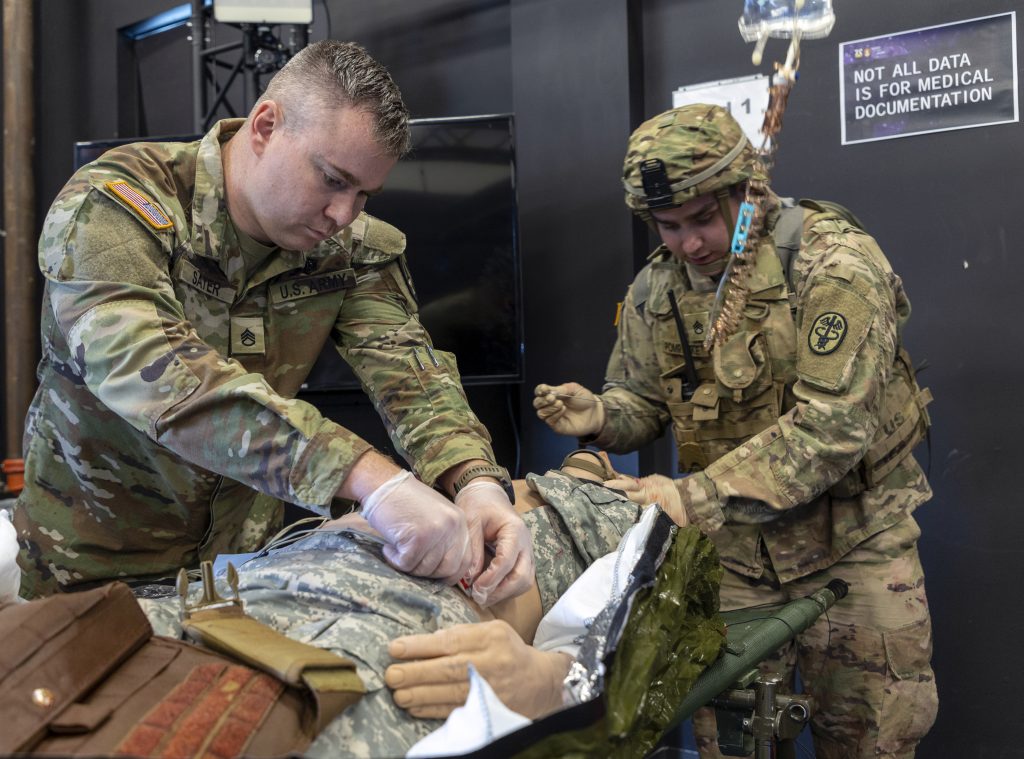
UP TO THE CHALLENGE: Maj. Kenny Torres of Army Futures Command demonstrates the pull-up bars during the command’s Murph Challenge event at Camp Mabry, Texas, on May 26. The Army is assessing whether incorporating fitness tracking wearables, which some Soldiers already use in their personal lives, into Army human performance initiatives could improve training and conditioning outcomes. (U.S. Army photos by Austin Thomas, Army Futures Command)
How tech-forward Army human performance programs are accelerating force readiness.
by Maureena Thompson
Building the Army of the future requires much more than strategic investments in modern weaponry. From improving the speed and accuracy of information-sharing to piloting innovative talent management structures, the Army continues to focus on investing thoughtfully and extensively in its greatest asset: its people.
While future readiness efforts span the Army’s Soldier and civilian workforce, they are especially important for members of the close combat force, who are likely to encounter increasingly dynamic, fast-paced and demanding forms of warfare in the years to come. As such, a number of Army modernization initiatives are studying how the Army can rapidly and effectively enable optimal warfighter health.
Included in these efforts are applied research programs that assess the utility of personal fitness trackers and the data they produce, as well as in-depth research on challenges to peak Soldier wellness. The Holistic Health and Fitness Management System (H2FMS) and Optimizing the Human Weapon System (OHWS) are two such programs examining how the Army can better gather and use human performance data, so that leaders—and Soldiers themselves—can implement intentional changes to strengthen readiness and solidify resiliency.

MORE TO IT: Sgt. Patrick Hill of the Texas National Guard participates in the Army Futures Command Murph Challenge at Camp Mabry, Texas in May. For many participants, completing the strenuous workout—held in honor of fallen U.S. Navy Seal Lt. Michael P. Murphy—requires both physical and mental toughness.
HOLISTIC HEALTH AND FITNESS MANAGEMENT SYSTEM
Through the H2FMS program, which commenced in August 2021, the Army Applications Laboratory (AAL) is exploring the power of enhanced health monitoring and streamlined data management.
H2FMS seeks to identify the best athlete management system (AMS) applications available on the commercial market and test their effectiveness on Soldier populations, with the eventual goal of implementing use across U.S. Army Forces Command.
The project—which launched a six-month pilot in May to test three AMS apps—evolved out of an 82nd Airborne Division request to AAL for assistance with finding tools to advance human performance and readiness while enhancing data-driven decision making.
“Operational units’ demand that we have solutions to improve our humans so they can be ready and lethal once they reach the battlefield,” said Maj. Nick Rinaldi, project manager for the H2FMS program. Rinaldi noted that AAL is well-suited to handle the task because the center focuses at “the warfighter level to identify pain points, refine and curate problems, and then source solutions where we see gaps.”
He added that the need for H2FMS reflects “a unit problem that every military entity with humans has: We can’t see ourselves well enough to make informed decisions on our human performance as it relates to Soldier lethality.”
By “see,” Rinaldi means more than just observe in action over a brief period of time. He and his team are interested in understanding the bigger and more enduring picture of individual and unit health through rigorous, long-term data collection and analysis—the type that can illuminate issues a person may not even be aware of.
“This isn’t just about the technology,” Rinaldi said. “It’s about culture and habit-forming.”
Through conversations with Soldiers and leaders, as well as integration with broader Army holistic health and fitness efforts, AAL ascertained that the most compelling solutions would address a spectrum of wellness needs, from physical and mental health to sleep, nutrition and spiritual wellness. Some of these needs might be best supported through in-person outreach or personalized surveys, whereas others could benefit from consistent, objective and tech-enabled health monitoring.
Wearable sensor devices, which collect and relay human performance data to AMS platforms and individual users, thereby driving health decisions, are promising because they provide concrete data, offer interactive capabilities and are already familiar to many Soldiers. Fitbit products fall within this broad category, for example, as does the Health app that comes pre-installed on iPhones.
Rinaldi shared that wearable sensor devices have been employed with “varying degrees of success” in U.S. Special Operations Command but are not broadly used across the Army. Through H2FMS, the Army aims to pinpoint and tailor a solution, or multiple solutions, that could eventually be rolled out to all of its equipped brigades within U.S. Army Forces Command and U.S. Army Training and Doctrine Command.
The version of AMS technology that the Army is looking to incorporate would meet the needs of multiple types of Soldiers in multiple wellness areas. Accordingly, the three platforms currently undergoing assessment via the H2FMS pilot are being tested by groups of infantry, military intelligence, medical battalion and reserve Soldiers.
H2FMS also wants to improve data sharing and preservation across various systems. The program is working to foster creation of an “agnostic data storage solution that allows governance of these types of data collection apps without mandating one in particular, which creates flexibility for the divisions and brigades to have a choice in AMS platforms while still keeping the data collected on the individual persistent between units and visible at the Headquarters, Department of the Army level,” Rinaldi explained.
H2FMS recognizes that finding the right solutions is key, but so is enabling their rapid implementation, which is why the program syncs its efforts closely with other Army holistic health and fitness initiatives.
“Seeing what’s possible is great but being able to deliver a product that can get implemented in less than two years is critical if we deal in terms of software and data,” Rinaldi said. “We are moving appropriately fast and with significant synchronization between science and technology, operational units and transition partners to get this in the hands of warfighters at the speed of relevance.”
Rinaldi underscored that “outcomes from this project not only provide solutions to our warfighter now, they inform our science and technology efforts such as OHWS and MASTR-E on potential advances in AMS solutions,” referencing the Measuring and Advancing Soldier Tactical Readiness and Effectiveness (MASTR-E) program, which aims to measure and predict Soldier combat performance more precisely.
AAL collaborates regularly and closely with the U.S. Army Combat Capabilities Development Command (DEVCOM) Soldier Center and other Army and joint force stakeholders to ensure human performance needs of the warfighter are assessed rigorously and holistically.

HEALTHY FUTURE: Command Sgt. Maj. LaQuaine Bess of Army Futures Command participates in the command’s Murph Challenge at Camp Mabry, Texas in May. To prepare Soldiers for the future, the Army is addressing a wide range of wellness needs.
OPTIMIZING THE HUMAN WEAPON SYSTEM
The mission of the Soldier Effectiveness Directorate at the DEVCOM Soldier Center is “to deliver unprecedented capability through innovation, research, development and technical integration to maximize Soldier effectiveness and readiness.”
The importance of this undertaking is not something the directorate takes lightly, and its commitment to furthering Soldier readiness is apparent in the robustness of the programs it executes, including the OHWS program.
OHWS, which is jointly supported by DEVCOM and the U.S. Army Medical Research and Development Command (MRDC), originated from a question posed in 2020 by the Office of the U.S. Assistant Secretary of the Army for Acquisition, Logistics, and Technology, which was essentially, “Can you use commercial, off-the-shelf wearable technologies for diagnostics of COVID-19?”
While the answer at the time was no, DEVCOM and MRDC did note that commercially available technologies could assist with Soldier “screening and triage” in operational settings, as well as provide “better leader engagement tools in order to promote well-being and optimization of the warfighter,” explained Joseph Patterson, a Soldier performance strategist at the DEVCOM Soldier Center and project manager for the OHWS program.
As a result, OHWS was designed to investigate whether and how wearable technologies could support the operational readiness of Soldiers preparing for deployment, recognizing that COVID-19 and stress could both have negative effects on numerous health parameters.
“Your physiology doesn’t care if you’re sick or you’re stressed because you’ve had a bad fight or you’re stressed because you went on a 12-mile road march,” Patterson said. “Physiology just responds to stress; it doesn’t care what the stress is.”
With members of the 4th Battalion, 31st Infantry Regiment, 2nd Brigade Combat Team, 10th Mountain Division serving as study subjects, the program began focusing on how to use wearable sensors and AMS products to evaluate core concerns of susceptibility to illness, enhanced mission command, prevention of injury, sustainment and optimization.
“We take best-of-breed sport technologies and bring them into the military to give us insights that we’ve never had before,” Patterson said of the process.
The program currently is testing the Oura Ring to track recovery and sleep; the Polar Grit X Pro outdoor watch to track exertion, including heart rate and muscle load; and the Smartabase software platform to collect and analyze aggregate performance data.
The program started testing the effectiveness of commercial off-the-shelf wearables and athlete management software with a cohort of 600 infantry Soldiers, but hopes to expand that figure to 4,000, evaluating the impact on an entire brigade combat team.
“It’s a true partnership between research and the operational community,” Patterson said, emphasizing that the point is not the specific hardware or software but rather enabling more reliable and robust human data to inform operational decision-making.
OHWS is also exploring whether a bring-your-own-device model would be feasible for Soldiers already using personal commercial wearables, in order to “leverage the investments that people are already making for themselves.”
AMS and wearables are influential because they can amplify training, education and leadership around Soldier health and wellness. If devices can show an individual how their choices impact their performance, they can then feel empowered to make changes that result in a healthier lifestyle and greater longevity. At the same time, health trackers worn by a group of Soldiers can collectively provide leaders with additional engagement tools and new information on how to create the best performance ecosystems possible.
“When it comes to data, context is king,” Patterson said.
| PROMOTING WELLNESS AND HEALTH As the Army modernizes how it tracks and promotes Soldier wellness, it is also developing more innovative, effective and resilient health care concepts and infrastructures. Plans for these future-oriented systems and approaches are captured in the Army Medical Modernization Strategy, which outlines how the Army will transform its formations, capabilities and people to build a state-of-the-art Army Health System. |
Beyond the operational environment, OHWS program wearables have been tested in combat diver qualification and maritime preparatory courses, as well as in best warrior, leader or medic competitions. Using the devices in elite training settings can illustrate “how states in readiness ebb and flow,” providing OHWS researchers and unit leaders with insights on how to hone performance. “We look at these tools and how they actually make people smarter, faster, more lethal and precise at the individual level,” as well as how they influence “echelon-based decision-making,” Patterson explained.
“Our goal is that human performance data becomes an integral part of mission command, movement, maneuver, protection and sustainment, which are warfighting functions,” he elaborated. “If we can figure out how we fight with this data, then we’re always putting our formations in a position to succeed instead of fail.”
Initial results have already prompted some adjustments to training battle rhythms at the battalion level to allow for more deliberate and effective rest cycles. Signals captured by the wearables have also increased leaders’ awareness of Soldier social and emotional well-being and enabled timely interventions with individuals experiencing abnormal levels of stress.
The program’s evaluation of devices is carried out in coordination with complementary efforts by other branches of the military as well as with university research partners.
“We work synergistically across DOD to make sure we understand the validation of these devices,” including “what they’re good for and what they’re not good for,” Patterson said. “This is all about trying to have a ‘coalition of the willing’ across the Services, because the human is the only capability that is constant within the Services.”
OHWS, like H2FMS, looks to support health and wellness as part of the Army holistic health and fitness effort.

MEDICAL CAPABILITY: Soldiers demonstrate new medical technologies during MRDC’s Capability Days at Fort Detrick, Maryland, in April.
CONCLUSION
In addition to creating programs that assess how to best collect and use Soldier fitness and wellness data, the Army conducts an array of in-depth research focused on understanding and improving Soldier health.
Researchers at the DEVCOM Army Research Laboratory, for example, investigate and publish research papers on topics ranging from neurological impacts of sleeping during the day to the effects of prior mental fatigue on marksmanship. Meanwhile, researchers at MRDC’s Walter Reed Army Institute of Research and U.S. Army Research Institute of Environmental Medicine have performed research on the effects of sleep loss on marksmanship, musculoskeletal injuries and resilience; with additional research on how to support readiness and recovery from sleep restriction and deprivation in the operational environment.
By uniting these and other activities with performance development programs being carried out across the Joint Force, the Army is helping to ensure that tomorrow’s Soldiers are equipped with the advanced human performance knowledge, skills and resources they need to succeed in future operational environments.
For more information, go to: https://armyfuturescommand.com/
MAUREENA THOMPSON is a contracted writer and editor with Army Futures Command in Austin, Texas. She holds a Master of Public Policy degree with a concentration in national security from Duke University, North Carolina and a B.A. in English from the University of California, Los Angeles.


